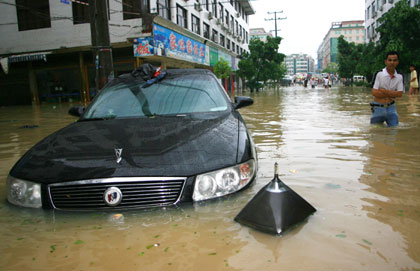With the recovery of the bodies of eight more people in Fuding city of east
China's Fujian Province, the death toll from Typhoon Saomai, the strongest to
hit China in half a century and now a tropical depression, has risen to 114,
with at least 183 others missing.

The streets of Lingxi
town in Cangnan county, Zhejiang province, are still submerged August 12,
2006 after Saomai, the strongest typhoon in 50 years, landed and brought
heavy rains. [Xinhua] |
As of Saturday night,
Fuding city reported 1,350 injured in they typhoon, and suffered an economic
loss of 2.5 billion yuan (312.5 million US dollars), said Zhao Fangli, deputy
head of the general office of the Fuding City Flood Control and Drought Relief
Headquaters.
Fuding was the worst hit by the Saomai in Fujian Province, where trees were
uprooted, houses flattened or seriously damaged.
"Almost the whole village was flattened," said a villager of Baisheng
Village, with more than 300 households, of Shanqian Community of Fuding city.
Shacheng Township of Fuding city lost more than 1,000 fishing boats to
Saomai, which flattened half of the houses of the township's over 8,000
households.
East China's Jiangxi Province reported two deaths from the typhoon as of
Saturday.
The provincial meteorological department said the rainfall in two counties in
Jiangxi was over 200 millimeters from Thursday to Friday and in 11 counties over
100 millimeters.
The provincial flood control and drought relief headquarters said altogether
980,000 people from the cities of Fuzhou, Nanchang, Yichun and Shangrao were
affected by the downpour-triggered disasters.
The department said Saomai destroyed six small reservoirs in Jiangxi and
brought the province 348 million yuan (about 43.5 million U.S. dollars) of
economic losses.
Six people in Lishui City in east China's Zhejiang Province were killed in a
landslide that was triggered by torrential rain, said Xiao Jianzhong, vice mayor
of Lishui.
Eighty-one people are dead and 11 are reported missing in Wenzhou, a booming
port city of more than 1 million people which received the brunt of the typhoon.
At least 2.1 million people have been affected and 18,000 houses destroyed in
Zhejiang. The downpour has swamped 56 provincial roads and national highways.
In Zhejiang, the typhoon caused an economic loss of 4.89 billion yuan (611
million U.S. dollars). The number of people with their houses being destroyed
has not yet been estimated.
Fujian Province reported 25 deaths and at 130 missing. More than 1.45 million
people have been affected and 32,700 houses destroyed.
The typhoon also damaged 68,800 hectares of crops, shut 234 factories and
mines, resulting in a direct economic loss of 6.36 billion yuan (795 million
U.S. dollars) in the province.
Saomai, the eighth typhoon in China this year, slammed into Cangnan County of
Wenzhou City at 5:25 p.m. Thursday. It was downgraded to a tropical depression
by 11 a.m. Friday.
Chinese Vice Premier Hui Liangyu, who is also chief of the State Flood
Control and Drought Relief Headquarters, urged governments to make the safety of
people their top priority and work to reduce casualties and economic losses to
the minimum.
He urged local governments to prevent more floods and landslides, restore
electricity and communication links and open roads as soon as
possible.